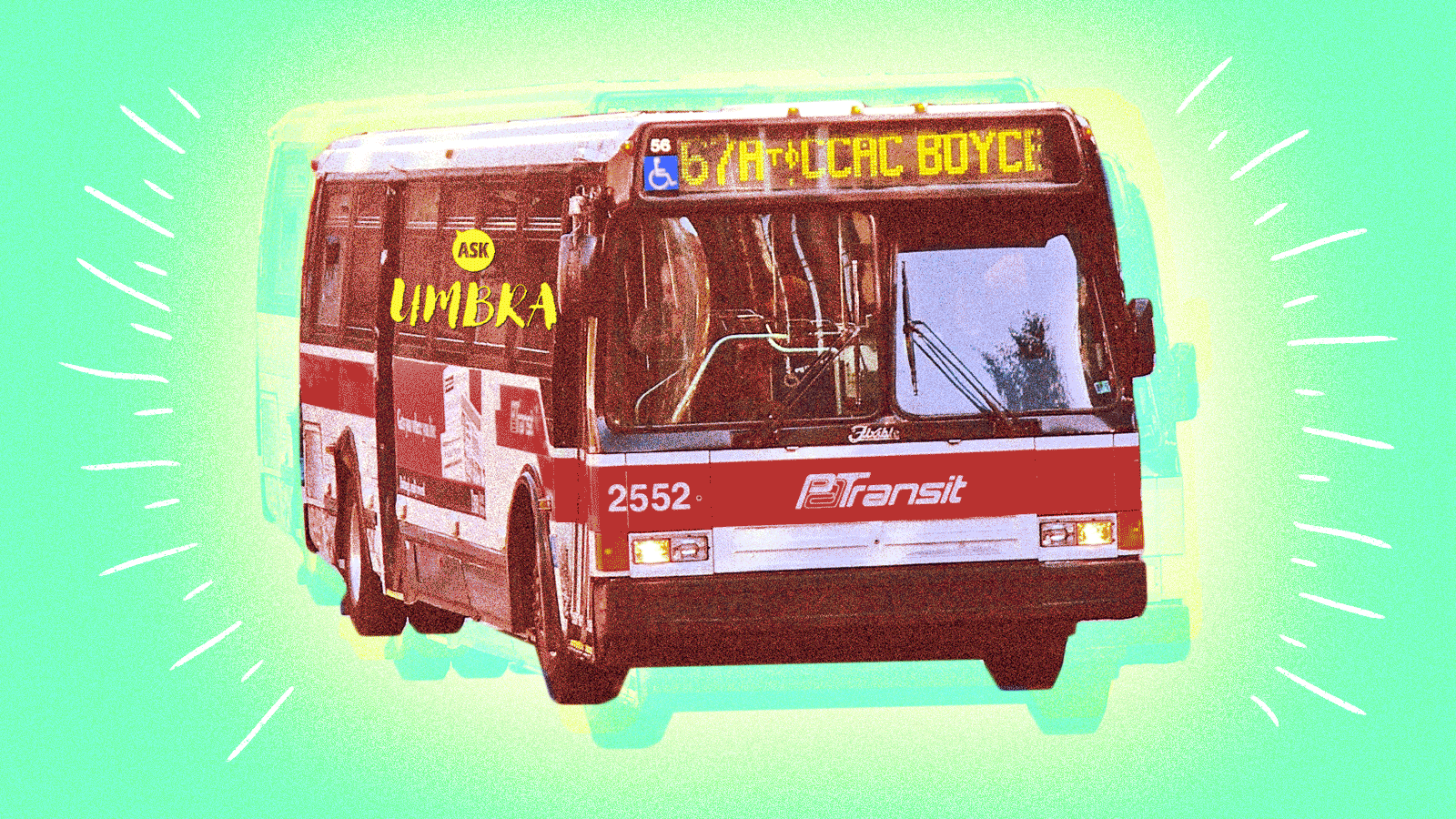Q. Dear Umbra,
Buses seem like a really obvious way to make cities more climate-forward. Why don’t more people take the bus? How can we change that?
Really Indignant & Devoted to Equitable Roads
A. Dear RIDER,
You’re not alone in honing in on public transportation as a climate solution. When the whole world is panicking about us having 11 or so years to drastically curb CO2 levels and try to avoid the worst consequences of climate change, it makes a lot of sense to target transportation, the largest source of U.S. emissions! And a very effective way to shrink that carbon footprint is for cities to reduce the number of single-passenger trips by providing excellent public transportation and safe biking and walking infrastructure.
Buses, in particular, are excellent car alternatives for cities looking to go greener. For one thing, they’re much cheaper up front than light rail or even rapid transit systems because a lot of the infrastructure they require (roads) is already in place. Bus routes are also flexible, meaning they work well in the less dense neighborhoods that make up most American cities. And they’re faster to implement: The average light rail system easily takes 10 years to get up and running, which doesn’t sound so great with that whole 2030 deadline on the horizon.
And yet even in cities where people seem to be on the (metaphorical) climate train, too many are hesitant to get on the (literal) bus! Part of that has to do with the longstanding stigma around buses — the idea that they’re cumbersome and slow and dirty (we’ll get to that in a moment). As a result, bus ridership is falling in most metro areas. Except, that is, in Pittsburgh, Pennsylvania, where I grew up.
I didn’t get my driver’s license until I was 21, and taking the city bus in Pittsburgh was, in more than one sense, a wild ride. It afforded me a lot of freedom: I didn’t have to ask my parents for rides or to borrow the car, I didn’t have to tell them where I was going because I could get there myself, it was basically free with my bus pass from the city school district, and I developed a pretty advanced mental map of the city at a young age.
But there were mishaps, too. I spent a lot of time waiting in the freezing, sleeting cold at uncovered bus stops; vehicles broke down or seemingly disappeared into the ether; and certain routes required me to devise insane, convoluted connections. Once I was on a particularly harrowing road that runs along a cliffside when the operator, without explanation or much of an apology, simply fell asleep while driving. Nonstop thrills!
So I was both gratified and baffled to see that in 2018, Pittsburgh bus ridership grew by about 3 percent, more than any other metro area in the country. That’s especially surprising considering that in 2006 — shortly before I left the city to go to college — about a third of the Port Authority’s bus service was cut due to budget issues, and it’s never been restored.
So why is bus ridership so robust in Pittsburgh as it’s falling in many other places (even lefty environmentalist havens like Portland and Denver)? Could the Paris of Appalachia hold the secret to getting folks out of their cars and onto public transportation? I set out to investigate.
David Huffaker, the newly appointed chief development officer for the Port Authority of Allegheny County, told me that the Pittsburgh metro is one of the only places where “buses are king, and the rail is kind of secondary.” (Transit Center data shows that all ridership growth in Pittsburgh in 2018 came from buses alone — rail ridership actually dropped.)
The city’s bus system hasn’t done a major service expansion or redesign, but despite its age, it particularly excels at speed, at least along specific channels. The system threads across the city, including the East Busway, a completely protected seven-mile highway that’s exclusively reserved for high-speed bus routes. The East Busway was one of the first bus rapid transit systems (a.k.a. BRTs) when it opened in the early 1980s, and it’s still pretty impressive to city planners to this day! There’s also a West Busway, developed more recently, and protected bus lanes on north and south freeways.
“The folks who created BRTs around the world look back to the East Busway as the prototypical BRT,” said Chris Briem, regional economist in Urban & Regional Analysis Program at the University of Pittsburgh.
Culture-wise, it’s fairly normal for locals to take alternative forms of transportation to get to work. Only 64 percent of Pittsburgh commuters drive to work, and 17 percent use public transit. (Nationally, 86 percent of commuters drive and 5 percent use public transit.) But that car-free mentality (and opportunity) doesn’t necessarily apply outside of the city. If you look at Allegheny County, 81 percent of the population drives to work — 72 percent without any additional passengers.
Another factor in Pittsburgh’s growing bus-ridership: the city’s changing demographics. Although the population hasn’t actually grown in 10 years, it has become a younger, more professional, and wealthier city than it was when I was riding the PAT bus. That shift has translated to more commuters, but hasn’t necessarily boded well for the city’s low-income population. Poorer households have been priced out of the city and pushed to outlying areas, which are not as well served by public transit — especially since the cuts of 2006.
I’d be remiss in not mentioning that PAT is also hampered by several unfortunate factors: One, it’s almost entirely dependent on funding from the state of Pennsylvania, which has a lot of transportation priorities outside of urban transit systems. Two, it’s trying to create a system that works for everyone in a city with a lot of geographical challenges: precipitous hills, pencil-thin windy streets, and rivers that cut the city into three bizarrely-shaped chunks.
Pittsburgh’s ridership increase has largely been driven by students traveling in and out of the city’s university-dense center, and by new, “unconventional” commuting routes. Laura Wiens, director of Pittsburghers for Public Transit, said that people living in the outskirts — or even more remote city neighborhoods — don’t reap the same transit benefits as those living close to downtown. “We’ve done surveys on people displaced from the city. People are taking Uber and Lyft, they’re socially isolated, they lose their jobs, transportation costs rise.”
And since car infrastructure is still good and parking is cheap, it’s not yet a city where people use public transit for pretty much anything outside of work. “I think those in better economic conditions don’t rely on the bus as much,” said Jay Ting Walker, vice president of the Allegheny Transit Council. “When there’s no traffic, outside of commuting hours, you can zip around the city so fast in a car, it’s crazy. It’s very easy to drive in Pittsburgh, so if you have a car, it makes sense to use it.”
Ting Walker says that difference is especially apparent when you look at the ethnic and racial breakdown of riders at different times of the day. “During 9 to 5 commuting hours, there are a lot of white people in suits,” he said. “Every other time — weekends, nights — very few white people on the bus. It’s a stark difference.”
Race has a lot to do with the cultural acceptance or rejection of public transportation. New rail lines or rail stops are more associated with gentrification of a neighborhood than bus lines or bus stops. Ting Walker says lingering stereotypes (e.g., trains are for white people, buses are for black people) can lead to “rail fetishization,” where wealthier, whiter residents falsely think of buses as run-down, lesser transportation options. “When I see a person saying we want trains, not buses, that sets off a red flag,” he said. “Meanwhile, busway systems are pretty decent, but we have so many examples of crappy trains.”
But stereotypes aside, one legitimate reason that buses are less popular than trains is their unpredictability: Theoretically, a bus could have the freedom to just jump off its route, and then where would you be! It could get stuck in traffic. It could break down. You could wait an hour for a bus that just never, ever comes! (It Happened To Me … many times.) Humans tend to prefer a sense of control, particularly when it comes to getting to work on time.
Cities and their transit agencies can resolve some of these problems in a couple of ways, such as: creating dedicated bus lanes, doing better maintenance on vehicles, and implementing those snazzy real-time timetables that tell you when the next bus is coming. (Smartphone apps are a good start, but they also require riders to have smartphones, which isn’t super equity-minded.)
And while it’s nice to have advertising and awareness campaigns that promote bus transit as enjoyable and preferable to driving — which I genuinely believe is true! — ultimately, bus-riding has to be made more appealing than driving. Most American cities have already been built around cars, which means metros may need to create disincentives for driving — such as congestion pricing, more expensive or decreased parking, and trimming car lanes to make room for bikes and buses.
In Pittsburgh, the mayor’s Climate Action Plan aims to increase transit commuter trips by 100 percent and decrease single-passenger vehicle commuter trips by 50 percent by 2030, but no meaningful legislation has been passed to disincentivize driving and make room for buses. So while it may be ahead in rides for now, it’s going to have to work just as hard as other cities to maintain that trajectory. And it’s also crucial to point out that even though ridership is up, it’s not as high as it was when Pittsburgh had greater bus service in the early aughts.
When requesting funding for the state, PAT’s Huffaker said the county is hoping to eventually restore some of that lost service. “We’re cognizant of not saying that our operating baseline is what we’re getting today, but rather where we were 15 years ago.”
Anyway, RIDER, I love the bus. I like having someone else drive me around, I like thinking about the efficiency of bus routes, I like making a climate-friendly choice without having to exercise, and I am a shameless people-watcher so I like that part, too. I think a lot of people could take some pages out of our shared book, but most importantly, those people should be the ones who make the laws that shape the streets of cities and counties.
Meanderingly,
Umbra



